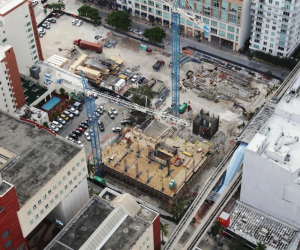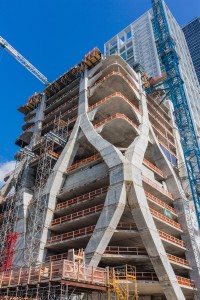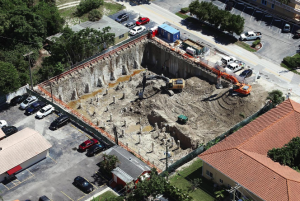Arranging huge tower cranes to blow with the wind like a weather vane, putting away debris that could become projectiles, emptying out dumpsters of loose material.
Across South Florida, builders and developers were busy preparing active construction sites on Wednesday, as Hurricane Matthew, a powerful Category 3 storm, barrels toward our coastline.

The Patricia and Philip Frost Museum of Science
Patricia and Phillip Frost Museum of Science
At the massive construction site for the $305 million Patricia and Phillip Frost Museum of Science just north of downtown Miami, crews were securing temporary shoring, tools and any other building materials that could become flying debris, said MacAdam Glinn, senior vice president and account manager for South Florida for Skanska USA.
“That’s really the biggest hazard — if it becomes flying debris,” he told The Real Deal.
The materials were stored inside, within semi-finished exhibit halls, that were then closed and locked tight. Larger construction items, too big to take inside, were bundled up and secured, he said.
And windscreens along the fence were taken down because they can become sails.
“You take those down, allow winds to blow through the chain link and it severely reduces the potential damage to our construction site,” Glinn said.
Crews were also using plywood and shutter material to seal any openings where windows and doors have not yet been installed. Otherwise, if wind is allowed to pass through an unfinished building, “it can create uplift and damage or blow off roofs, depending on the strength of the storm,” he said.
Skanska has emergency generators ready to power the building and provide lighting, so workers can move through the building after the storm and assess any damage.
With the museum so close to the water, storm surge is a major concern, Glinn said. So the Skanska also has portable pumps to pump out water after the storm if it enters the building or the subterranean garage. Everything was to be in place by early Wednesday afternoon in advance of the storm.
“If you haven’t reserved those things, haven’t planned for this contingency, it can be a real problem,” he said.

Aerial view of the Vice construction site in downtown Miami
Echo Brickell, Muse and Vice
At Echo Brickell, Muse and Vice, the horizontal part of the tall tower cranes were being positioned to blow in the wind, which is called weathervaning, Aaron Sinnes, construction director for Property Markets Group, told TRD.
Cranes are designed to withstand winds of more than 150 miles per hour. So rather than dismantle the cranes, all high-rise developments keep them on site and unlock the horizontal section so it points itself downwind, he said.
Construction at PMG’s 52-story Echo Brickell condominium in Miami is at the 48th floor; 52-story Muse condo in Sunny Isles is at the 35th floor; and Vice, a 32-story apartment rental project in downtown Miami is at the second floor. Muse and Echo Brickell have one crane each; Vice has two.
John Moriarty & Associates is the general contractor.
“On Muse and Vice, typically the biggest concern is if you have a floor that hasn’t poured that is shored or supported. You want to pour your concrete to load the shoring, or else it can fly if it’s not loaded,” Sinnes said. “So on Muse we poured our next floor — either 34 or 35 — last night and at Vice we poured our second floor slab this morning, at 2 a.m.”
He said that with high-rise construction, installing the windows usually trails the working deck by 10 floors. “All the glass is impact resistant, so once the glass is in, you’re protected, theoretically,” Sinnes said.
On Wednesday, crews were taking materials from the non-enclosed working decks — like pallets of tile and block — to ground level, bulk bundling and anchoring them so they won’t fly away or become projectile.
Construction is suspended at all sites for Thursday and Friday and will likely resume on Saturday, Sinnes said, but it’s unclear what the costs associated will be, because projects allocate an allowance in the contract for hurricane preparedness. The delay is typically three to five days.
“Subcontractors’ costs gets billed to this allowance, ” he said. “Any time delays that may be incurred are granted, and any time you have a hurricane you have an extension of time.”
One Thousand Museum

One Thousand Museum
At the Zaha Hadid-designed One Thousand Museum tower north of downtown Miami, co-developer Gregg Covin said workers were securing lose debris and construction material inside, emptying dumpsters and making sure that the two tower cranes were in a weathervaning position. “You let the tower crane spin freely and it keeps pointed toward the wind,” he told TRD.
Construction at the 62-story condominium has reached the 22nd floor, where concrete was just poured.
Covin, a hands-on developer who also serves as general superintendent for spec home developer Todd Michael Glaser, visited 21 different construction sites on Tuesday and Wednesday, boarding up openings and bringing in outdoor furniture.
“It’s been a hectic two days,” Covin said. “I’m visiting every site and coordinating materials I see outside that need to be moved — getting my hands dirty moving materials and furniture.”
327 Royal Palm, the Fordham, the Elysian
Group P6, which is developing 327 Royal Palm, a 25-unit condominium in Boca Raton; the Fordham, a nine-unit development in Deerfield Beach; and the Elysian, a seven-unit condo, also in Deerfield Beach, brought in additional crews to tie up everything and make sure it’s secure on Wednesday.

327 Royal Palm
“We have sites that have wood and shorings and different elements of construction, so we are taking the time to secure everything,” Ignacio Diaz, general manager of Group P6, told TRD. “Thankfully we don’t have a crane up right now so we feel good about that.”
Like other developers, Diaz was taking the precautions in stride. He said the firm is prepared to handle at least one hurricane each season in South Florida.
“Weather happens,” Diaz said, “for sure.”
